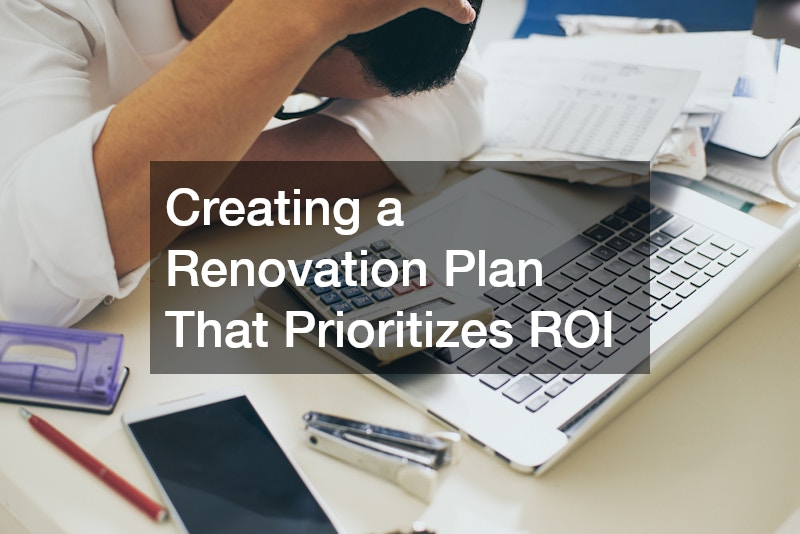Flipping houses can be a highly profitable venture when approached with the right strategy. However, the key to success lies in careful planning, smart budgeting, and knowing what to prioritize from the outset. Many first-time investors jump into a renovation project with excitement, only to find themselves overwhelmed by unexpected costs, lengthy timelines, or insufficient returns. That’s why a comprehensive house flip checklist is essential before you even pick up a hammer or call a contractor.
A well-structured checklist will help you assess properties accurately, identify high-ROI upgrades, manage permits and timelines, and stay on budget throughout the flip. Every decision should be driven by profitability and buyer appeal, ensuring you create a marketable home without overspending. Whether you’re a seasoned flipper or just starting out, this guide will serve as your go-to resource to plan, execute, and finish a successful flip with confidence.
Assessing the Neighborhood and Market Conditions
Before purchasing any property, you must evaluate the neighborhood. A great renovation in a declining area is unlikely to yield high returns. Look for locations with rising home values, improving infrastructure, and proximity to schools, parks, and retail areas. Research local crime rates, school ratings, and future development plans. These factors heavily influence resale value and marketability.
Drive around the neighborhood and take note of other homes. Are they well-maintained? Are there ongoing renovations or new builds? These signs indicate a healthy, active real estate market. Speak with local realtors to get insights on average days on market and pricing trends. Your house flip checklist should always begin with external variables before moving on to the property itself.
Understanding the local buyer demographic is also crucial. A flip meant for young families should prioritize safety features and outdoor space, while a home targeted toward retirees might focus on single-level living and low-maintenance landscaping. Knowing your buyer means better investment decisions at every stage.
Conducting a Property Walkthrough with Purpose
Once you’ve identified a promising location, schedule a detailed walkthrough of the property. Your initial inspection should be methodical and critical. Look for structural issues, foundational cracks, moisture damage, and outdated or unsafe electrical wiring. If you’re not experienced with structural assessments, bring a trusted contractor or inspector to identify any hidden red flags.
Pay attention to the layout of the home. Modern buyers prefer open floor plans, ample lighting, and practical storage. If the layout feels choppy or outdated, determine if walls can be removed or rooms reconfigured within budget. A smart redesign can increase perceived value significantly without excessive cost.
Don’t overlook the exterior. Evaluate the condition of the roof, windows, siding, and gutters. Issues in any of these areas can lead to costly repairs down the line. Add roof repair to your house flip checklist if there are any visible signs of damage, discoloration, or sagging. Curb appeal is one of the easiest ways to increase value quickly, so make sure the outside of the home is as marketable as the interior will become.
Budgeting with Precision and Planning for Contingencies
Setting a realistic budget is one of the most important parts of your house flip checklist. Every flip should begin with a clear financial plan that includes purchase price, closing costs, renovation expenses, holding costs, and a contingency buffer. Skimping on this step can lead to cash flow issues that stall the project or diminish your profits.
Start by creating a line-item budget that breaks down each section of the renovation. Include quotes from contractors when possible, and overestimate costs to account for unforeseen issues. Your contingency fund should be at least 10–15% of your total budget to handle surprises like mold remediation or structural reinforcement.
Don’t forget to include holding costs such as utilities, property taxes, insurance, and loan interest. These expenses add up quickly, especially if the flip takes longer than expected. The more detailed your budget, the fewer financial shocks you’ll experience during the project.
Securing Financing and Managing Cash Flow
Unless you’re paying cash, you’ll need to secure financing before closing on the property. There are several options available, including hard money loans, private lenders, home equity loans, and traditional mortgages. Each comes with different terms, interest rates, and levels of risk.
Hard money lenders are popular among house flippers due to fast approval processes, but they typically come with higher interest rates and shorter terms. Choose financing that matches your timeline and allows for flexibility in case of delays. Having access to reserve funds or a line of credit is also wise.
Cash flow management should continue throughout the renovation. Pay contractors according to progress milestones rather than in lump sums. Keep detailed records of all expenses and regularly compare actual spending against your original budget. This disciplined financial tracking helps ensure your house flip stays profitable from beginning to end.
Creating a Renovation Plan That Prioritizes ROI
Not all renovations are created equal. Focus your budget on upgrades that offer the highest return on investment. Kitchens and bathrooms tend to yield the best ROI, especially when updated with modern finishes, energy-efficient appliances, and stylish yet durable materials. A sleek kitchen island, subway tile backsplash, and quartz countertops can instantly elevate the home’s appeal.
Flooring is another critical component. Replacing worn carpet with hardwood or luxury vinyl plank can significantly boost perceived value. Paint is a low-cost, high-impact improvement—neutral colors create a blank canvas for buyers and help rooms appear larger and brighter.
Don’t over-customize. Choose finishes and features that appeal to the broadest range of buyers. Avoid overly bold color schemes, complex layouts, or luxury upgrades that won’t be recouped in the sale. Your house flip checklist should keep you focused on strategic improvements rather than personal taste.
Addressing Major Systems for Long-Term Reliability
Buyers pay close attention to the home’s core systems: plumbing, electrical, and HVAC. Even the most beautiful flip will struggle to sell if the furnace is outdated or the breaker box looks like a fire hazard. Before investing in cosmetic upgrades, assess the condition of these systems and budget for repairs or replacements if needed.
Schedule an HVAC service early in the process to determine if the system is functioning properly and meets current efficiency standards. Old or inefficient systems are dealbreakers for many buyers and could lead to delays during the inspection process.
Similarly, test the home’s plumbing infrastructure, especially if the property has well services. Contaminated or unreliable water sources require immediate attention. If your inspection reveals issues, consider upgrading filtration systems or exploring well pump replacements to ensure long-term functionality and compliance with local health regulations.
Prioritizing Exterior Enhancements for Curb Appeal
First impressions matter. Buyers often make judgments within the first few seconds of seeing a property. That’s why exterior upgrades should play a major role in your house flip checklist. Start with basic landscaping—mowed lawns, trimmed hedges, and weed-free flower beds make a powerful impact.
If the roof shows signs of wear, don’t hesitate to call a roofing company or professional roofer to inspect and advise. A new or well-maintained roof can become a key selling point and protect against water intrusion that could damage your interior finishes.
In addition, make sure the siding, doors, and windows are in good condition. If the house has any stucco or stonework, inspect for cracks or water damage. Replace damaged entry doors with impact doors that provide both aesthetic appeal and enhanced safety—buyers appreciate knowing their future home has secure and durable components.
Ensuring Structural Integrity and Drainage Systems
Foundations, crawl spaces, and basements often hide issues that can ruin an otherwise successful flip. Always inspect for cracks, sagging floors, or signs of past flooding. Any evidence of structural movement should be evaluated by a qualified engineer or foundation specialist. These issues are expensive but essential to address early on.
Water purifications are another major concern to consider for your house flip checklist. Poor grading or outdated drainage systems can lead to basement leaks or soil erosion. Correcting these issues may involve regrading the yard or installing French drains, both of which should be included in your budget.
If the property uses a septic system, contact local cesspool pumpers to evaluate the condition and ensure it’s functioning properly. A neglected septic system can become a health hazard and a costly repair that eats into your profits. Proper maintenance and documentation provide peace of mind to future buyers.
Maximizing Usable Space Inside and Out
Adding usable square footage or improving the layout of existing space increases value without expanding the home’s footprint. Knocking down non-load-bearing walls to create open floor plans is one of the most cost-effective changes you can make. Open-concept layouts are highly desirable and help smaller homes feel more spacious.
Also consider finishing attics, basements, or garages to add functional living space. These areas can become home offices, gyms, or guest suites—features that today’s buyers appreciate more than ever. Adding a closet and heating/cooling system may be all that’s needed to classify these areas as livable square footage.
Outdoors, patios and decks add entertainment value. Create inviting outdoor spaces with simple upgrades like string lighting, potted plants, and fresh paint. Buyers often imagine themselves entertaining in the backyard, so stage these areas to support that vision and make the property feel complete.
Scheduling Inspections and Final Walkthroughs
Before listing, your house flip checklist should include a series of inspections to ensure everything meets local code and buyer expectations. Hire a third-party inspector to walk through the property and identify any lingering issues. Addressing these in advance helps avoid last-minute negotiations or failed deals.
If your area requires municipal inspections, schedule them well in advance and ensure all permits are closed. Building inspectors often have long lead times, so plan accordingly to avoid delays.
During your final walkthrough, pay attention to details. Check that all light fixtures are working, outlets have covers, appliances are installed correctly, and paint lines are clean. These small touches signal professionalism and care—two things that instill confidence in potential buyers.
Staging and Marketing the Finished Product
Once renovations are complete, staging your property can make a significant difference in how quickly and profitably it sells. Professionally staged homes often appear larger, cleaner, and more functional. If you’re not using a professional stager, opt for minimalist décor that highlights space and layout rather than personal taste.
Use high-quality photography and video tours to showcase your flip online. Most buyers start their search on real estate platforms, so compelling visual content is essential. Be sure to highlight the upgrades and new systems included in the renovation, including well services, roof repairs, or HVAC upgrades.
Create a compelling listing description that emphasizes the home’s transformation and move-in readiness. Words like “fully renovated,” “modern updates,” and “designer finishes” resonate with buyers and justify your asking price. Work with a knowledgeable agent who understands the local market and knows how to position your property for a quick, profitable sale.
Timing the Market and Pricing Strategically
Market timing can make or break your house flip. Ideally, you should aim to complete and list your property in spring or early summer, when buyer demand tends to be highest. However, if market conditions are favorable, you can flip year-round—just be aware of local cycles and trends.
When pricing your property, review comparable sales in the area, factoring in square footage, lot size, and upgrades. Price slightly below market if you want to generate buzz and spark bidding wars. Price too high, and your property may sit too long, leading to markdowns and carrying costs that erode profits.
Remain flexible. If showings aren’t generating offers, consider a price adjustment or incentive like paying closing costs. The goal is to sell quickly while maintaining your target profit margin. Having a solid strategy for pricing and timing is just as important as the renovation itself.
Flipping houses successfully requires more than a vision—it demands discipline, planning, and execution. With the right house flip checklist in hand, you can approach every project with clarity and confidence. From choosing the right property and budgeting strategically to coordinating contractors and marketing the final product, every detail plays a role in your outcome.
Each decision should be guided by what appeals most to buyers and what adds tangible value. Whether it’s bringing in a local roofer to improve curb appeal, replacing a well pump to ensure water reliability, or scheduling cesspool pumpers to handle septic issues, these small actions protect your investment and maximize returns.
Stick to your house flip checklist, make informed choices, and you’ll position yourself for a profitable flip—one that turns a distressed property into someone’s dream home.





